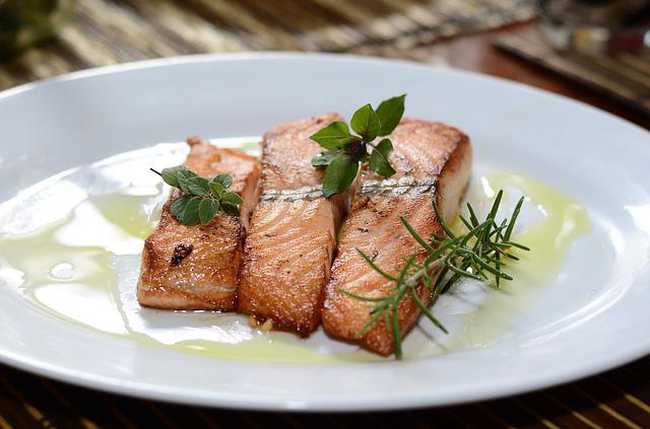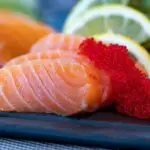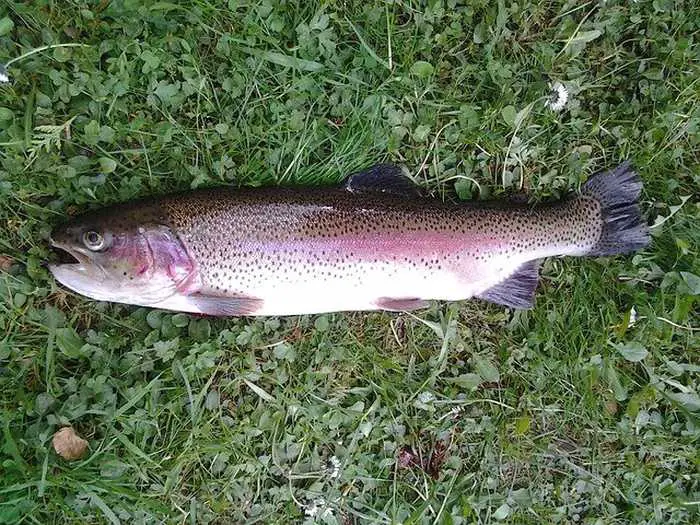While raw salmon is perfectly safe to eat, undercooked salmon can pose a serious health risk. Salmon that has not been cooked to an internal temperature of 145 degrees Fahrenheit may contain harmful bacteria that can cause food poisoning. Additionally, undercooked salmon may also contain parasites that can cause illness. For these reasons, it is important to make sure that your salmon is properly cooked before consuming it.
If you are unsure whether your salmon is fully cooked, the best way to test it is with a food thermometer. Insert the thermometer into the thickest part of the fish and check to see if the internal temperature has reached at least 145 degrees Fahrenheit. If it has not, then cook the salmon for additional time until it reaches this temperature.
-What are the risks of undercooked salmon?
Salmon is a type of fish that is often eaten raw or undercooked. Some bacteria or viruses that may be present in raw salmon include: Salmonella, Shigella, Vibrio, Clostridium botulinum, Staphylococcus aureus, Listeria monocytogenes, Escherichia coli, Hepatitis A, and Norovirus. Most infections of these bacterial and viral species are caused by eating fish.
The risks of undercooked salmon depend on the individual bacteria or virus present. For example, infection with Salmonella can cause diarrhea, vomiting, and fever; while infection with Hepatitis A can cause liver damage. It is important to note that not all strains of each bacteria or virus will cause illness in humans; some may only cause mild symptoms or no symptoms at all.
To reduce the risk of foodborne illness from salmon, it is recommended to cook the fish until it reaches an internal temperature of 145°F (63°C). This temperature should be measured using a food thermometer inserted into the thickest part of the fish. If you choose to eat raw salmon (such as sushi), it is important to purchase the fish from a reputable source that uses fresh and properly refrigerated seafood.
-How can you tell if salmon is properly cooked?
The best way to tell if salmon is properly cooked is to use a food thermometer. Salmon should be cooked to an internal temperature of 145 degrees Fahrenheit. You can check the internal temperature of the fish by inserting the food thermometer into the thickest part of the flesh. If the salmon is not yet at 145 degrees, continue cooking it until it reaches that temperature.
-What is the safest way to eat raw salmon?
If you are planning to eat raw salmon, there are a few things you need to keep in mind. First of all, it is important that the salmon is properly stored and prepared. This means that it should be kept refrigerated and should not be frozen. Additionally, the salmon should be cooked thoroughly before eating.
However, even if you take these precautions, there is still a risk involved in eating raw salmon. If you have a compromised immune system, it is best to avoid this food altogether. Raw salmon can contain harmful bacteria that can cause serious illness in people with weak immune systems.
If you are unsure about whether or not it is safe for you to eat raw salmon, please consult with a healthcare provider. They will be able to give you specific advice based on your individual health needs and situation.
-How to cook salmon to ensure it is safe to consume?
To ensure that salmon is safe to consume, it is important to cook it properly. Salmon should be cooked until it reaches an internal temperature of 145 degrees Fahrenheit. When cooking salmon, be sure to use a food thermometer to check the internal temperature in the thickest part of the fish. Once the salmon has reached 145 degrees Fahrenheit, remove it from the heat and allow it to rest for 3-5 minutes before serving.
Salmon is a delicious and healthy option for a meal, but it is important to make sure that it is cooked properly in order to avoid any foodborne illness.
-Is there a difference between wild and farmed salmon when it comes to cooking them safely?
There is a difference between wild and farmed salmon when it comes to cooking them safely. Wild salmon are typically leaner and have less fat than farmed salmon. This means that they can overcook more easily and become dry. It is important to cook wild salmon on lower heat for a shorter period of time. Farmed salmon are typically higher in fat, which makes them more forgiving when cooking. They can be cooked on higher heat for a longer period of time without becoming dry or overcooked.
-What are some other food safety concerns when eating salmon?
In addition to the potential for mercury contamination, there are other food safety concerns when eating salmon. One is the risk of bacterial infection. Salmon can be contaminated with bacteria such as Escherichia coli and Listeria monocytogenes, which can cause serious illness. Cooking salmon to an internal temperature of 145 degrees Fahrenheit will kill these bacteria, but it is important to use a food thermometer to ensure that the fish has reached this temperature throughout.
Additionally, wild-caught salmon may contain chemical pollutants such as polychlorinated biphenyls (PCBs) and dioxins. These chemicals can accumulate in the fish over time and may be harmful to human health if consumed in large quantities. Farm-raised salmon may also contain these pollutants, although typically at lower levels than their wild-caught counterparts due to strict regulations on feed sources and environmental conditions. As with mercury contamination, cooking will not remove these chemicals from the fish.
When choosing salmon, opt for fresh or frozen wild-caught fish from Alaska or the Pacific Northwest whenever possible. These regions have stricter laws in place regarding pollution and contaminated water sources, so the risk of consuming tainted fish is greatly reduced.
-Can undercooked salmon be rectified if noticed after already being eaten?
If you have eaten undercooked salmon and are feeling ill, it is important to seek medical attention immediately. Undercooked salmon can contain harmful bacteria that can cause food poisoning. Symptoms of food poisoning include nausea, vomiting, and diarrhea. If not treated promptly, food poisoning can lead to serious health complications, such as dehydration and even death. While there is no guaranteed way to rectify undercooked salmon after it has been eaten, receiving prompt medical treatment is the best course of action to take.
– What are the symptoms of food poisoning from eating undercooked salmon?
The symptoms of food poisoning from eating undercooked salmon can vary depending on the type of food poisoning you have contracted. However, some common symptoms include nausea, vomiting, diarrhea, and abdominal cramps. If you experience any of these symptoms after eating salmon that has not been properly cooked, it is important to seek medical attention immediately as food poisoning can be very serious.
Is it OK to eat salmon a little undercooked?
No, it is not OK to eat salmon a little undercooked. The Centers for Disease Control and Prevention (CDC) recommend that people only eat fish that has been cooked thoroughly in order to avoid the risk of infection from tapeworms. Tapeworms can cause a number of health problems, including diarrhea, abdominal pain, and weight loss. In severe cases, tapeworms can lead to death. Japanese broad tapeworms are particularly dangerous because they can invade the intestines and cause serious damage. If you think you may have been infected with a tapeworm, it is important to see a doctor immediately so that you can receive treatment.
Is it OK for salmon to be pink in the middle?
The color of cooked salmon can vary depending on the type of salmon, how it was raised, and how it was cooked.Wild-caught salmon typically has a deeper pink color than farm-raised salmon. Salmon that is wild-caught in Alaska generally has the deepest hue, while wild-caught salmon from British Columbia tends to be lighter in color. Farm-raised salmon is usually light pink in color.
The way the salmon is cooked can also affect its color. For example, if you grill or smoke your salmon, it will likely have a darker exterior due to being exposed to direct heat. Baking or poaching your fish will result in a more uniform pink color throughout the flesh.
When it comes to determining whether or not your salmon is properly cooked, you should focus on its texture rather than its color. Gently press down on the center of your fillet with a fork – if it flakes easily and appears opaque all the way through, then it is fully cooked. If the center of your fillet still looks dark pink or red, then it needs to cook for a bit longer.
How can you tell if salmon is undercooked?
How can you tell if salmon is undercooked?
Salmon will change from translucent (red or raw) to opaque (pink) as it cooks. After 6-8 minutes of cooking, check for doneness, by taking a sharp knife to peek into the thickest part. If the meat is beginning to flake, but still has a little translucency in the middle, it is done. It should not however, look raw.
Undercooked salmon will be very pink and may even have some red areas. The best way to gauge whether salmon is cooked properly is to use a digital food thermometer. Raw salmon should register at 145 degrees F. Cooked salmon will be about 155-160 degrees F.
Can I eat medium-rare salmon?
Yes, you can eat medium-rare salmon. Chefs recommend eating salmon medium or medium rare because it has the best flavor when it’s flaky on the outside with a moist middle that melts in your mouth. The new standard for cooking salmon in restaurants is medium, but if you prefer your salmon cooked closer to rare, then go for it! Just know that the texture and flavor may not be as ideal as if it were cooked to a more moderate temperature.








